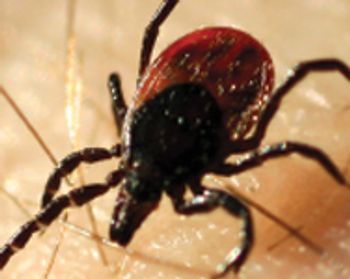
Sometimes misunderstood, misapplied, and maligned, medical guidelines are a valuable tool in improving patient care and should be widely incorporated in companion-animal practice.

Sometimes misunderstood, misapplied, and maligned, medical guidelines are a valuable tool in improving patient care and should be widely incorporated in companion-animal practice.

A list of selected feline parasiticides.

"My pet is itchy"--it's the most common reason clients visit a veterinary clinic. Flea allergy dermatitis is the most common dermatologic disease of dogs. As a veterinary technician, you need to understand why managing flea bites is so important for allergic dogs--so you can relate this important information to clients.

Orlando, Fla - A new survey shows that tick populations are not only increasing in number but tick-borne diseases are showing up in every state in the country.

People exposed to Toxoplasma gondii have an increased risk of developing schizophrenia, says a study published in the American Journal of Psychiatry.

Test your veterinary parasitology knowledge with this short interactive quiz.

National Report - A new study suggesting a link between infection with Toxoplasma gondii, a parasite commonly carried by pet cats, and schizophrenia may offer new hope and lead to possible treatments for the roughly 2 million Americans who suffer from the mental disorder, researchers say.

Obvious clinical signs may be apparent in only about 5% to 10% of dogs infected with B. burgdorferi. So the harder question is, how should we manage the vast majority of infected dogs that show no clinical signs?

This publication brings together leading parasitology and dermatology experts to examine the importance of a rapid kill time in flea control products.

Sacramento, Calif. - For the second year in a row, thieves hit Dr. Katie True's Midtown Animal Hospital in Sacramento, Calif. Roughly $4,000 worth of medication was stolen during a September break-in.

Outbreaks of equine viral arteritis (EVA) are infrequent in the United States but, because a large percentage of the equine population is susceptible, several leading experts continue to push for improved awareness and protective measures.

Jackson, Miss. - Cases of Eastern equine encephalitis (EEE) and West Nile virus (WNV) are up sharply in Mississippi this year, with EEE cases already more than double the 2006 totals, according to State Veterinarian Jim Watson, DVM.

Beltsville, Md. - When he found a live Lone Star Tick (Amblyomma americanum) on the agitator of his washing machine, entomologist John Carroll, of the United States Department of Agriculture's Agricultural Research Service, decided to find out how tough ticks really are.

Lexington, Ky. - 10/25/07 - The American Horse Council's National Issues Fall Forum will host a session on equine piroplasmosis (EP) and related issues, presented by Kent Fowler, DVM and chief of the Animal Health Branch at the California Department of Food and Agriculture.

Austin, Texas - 10/8/07 - A $13-million price tag is attached to an effort to eradicate the incursion of tiny fever ticks into a once tick-free five-county Texas area along the Mexican border, says livestock officials.

Do you recommend year-round preventives to help control parasitic disease and increase client compliance?

Yes. But oddly enough, few pet owners take the right steps to protect their pets, their families, and themselves from infestations (see Figure 1)

Manhattan, Kan. - Kansas State University's (KSU) veterinary college unveiled its Dryden-Merial Tick Research Center last month, a facility dedicated to disease-vector research relating to ticks that infest dogs and cats.

Given the number and kinds of effective de-wormers that are available, parasitologists often are asked why parasites continue to be prevalent and important disease agents of companion animals.

Concerned about the threat of feline heartworm infection, team members at Valley Animal Hospital in Roanoke, Va., decided to launch a campaign to educate clients.

GREENSBORO, N.C. - Three separate veterinarian surveys challenge commonly held beliefs about the prevalence of heartworm and intestinal parasites. "These studies do demonstrate that heartworm and intestinal parasites are endemic throughout most of the United States, including regions where prevalence is historically thought to be low," reports Dr. David Stansfield, director of professional relations for Novartis Animal Health.

Washington - The U.S. Department of Agriculture's (USDA) Animal and Plant Health Inspection Service (APHIS) is working to establish a voluntary trichinae-certification program for U.S. pork.

"The biggest myth that we deal with is that most people believe their dog or cat got fleas from direct contact with another pet.

National Report - Parasites are on the move. Warmer winters, exploding wildlife populations and reforestation are all fueling the trend.

Las Vegas - A Web site created to support a public-relations campaign about heartworm was unveiled at the recently concluded Western Veterinary Conference.